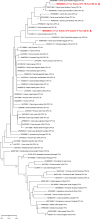First isolation and molecular characterization of canine parvovirus-type 2b (CPV-2b) from red foxes (Vulpes vulpes) living in the wild habitat of Turkey
- PMID: 36774498
- PMCID: PMC9921602
- DOI: 10.1186/s12985-023-01988-2
First isolation and molecular characterization of canine parvovirus-type 2b (CPV-2b) from red foxes (Vulpes vulpes) living in the wild habitat of Turkey
Abstract
Background: The canine parvovirus, with its many variants, is responsible for a pivotal and common viral infection affecting millions of dogs and other carnivore species worldwide, particularly the wild ones, which are considered as the main reservoir hosts. To that end, this study investigated the presence of canine parvovirus (CPV) in red foxes (Vulpes vulpes) living in wild habitats of several regions of Turkey.
Methods: We randomly collected 630 archival fox stool specimens from rural areas of 22 provinces and used real-time PCR to detect CPV.
Results: Two of the 630 (0.3%) stool samples were positive for CPV-DNA, named Tr-Fox/128(Aydın) and Tr-Fox/159(Manisa). We attempted to isolate the virus in a MDCK cell line, and cytopathic effects were observed four days post-inoculation. Three regions corresponding to the CPV capsid protein VP2 gene from extracted DNA of positive samples were amplified by conventional PCR, and the products were visualised, purified, and Sanger sequenced. Three overlapping DNA raw sequence fragments, were read, assembled, and aligned to obtain approximately 1.5 kb-long regions that cover most of the VP2 gene, then deposited in GenBank. After comparing the isolates with parvovirus sequences data of domestic and wild carnivores by BLAST processing, our isolates' similarity rate with each other was 99.40%, with base differences in 9 nucleotide positions. They were classified as 2b variant closely related to isolates from dogs in Turkey, Egypt, Iraq, Italy, Thailand, and China.
Conclusion: This study presents evidence of interspecies transmission of CPV, of which there are no reports on prevalence in wildlife carnivores of our country. Identification of CPV in red foxes threatens local and hunting dogs, which may contract the infection or disseminate it to other wild animal species or vice-versa.
Keywords: Canine parvovirus; Isolation; PCR; Phylogeny; Red foxes.
© 2023. The Author(s).
Conflict of interest statement
The authors declare that they have no competing interests.
Figures

 = provinces where fox stools were collected.
= provinces where fox stools were collected.
 = provinces where CPV-positive fox stools were detected
= provinces where CPV-positive fox stools were detected

References
-
- De Oliveira PSB, Cargnelutti JF, Masuda EK, Weiblen R, Flores EF. New variants of canine parvovirus in dogs in southern Brazil. Adv Virol. 2019;164(5):1361–1369. - PubMed
-
- Yang DK, Kang KS, Jo HY, Kim HH, Choi SS, Song JY. Isolation and identification of canine parvovirus type 2b in Korean dogs. Korean J Vet Res. 2015;55:163–167. doi: 10.14405/kjvr.2015.55.3.163. - DOI
MeSH terms
LinkOut - more resources
Full Text Sources
Research Materials

